About Hagi Yaki

Hagi was named as the headquarters of the Mōri Clan in 1604 and a kiln was subsequently opened under the patronage of the Hagi (Chōshū) domain. It was situated in the east suburbs of Hagi castle town in Matsumoto. The potter Rishakkō who had been brought over from the Korean Peninsula to Japan was put in charge of the pottery to support the technical work of the potters.
In the first half of the 17th Century the son of Rishakkō, Yamamura Sakunojō (also known as Mitsumasa, or Shōan) led the work of the kiln along with his uncle, Saka Kōraizaemon (also known as Rikei and Sukehachi). However, in 1675 the son of Yamamura Sakunojō, Yamamura Mitsutoshi and his apprentices moved to Fukukawa (present day Fukawa Yumoto, Nagato City). With the cooperation of the proprietor, Sakakura Kurōuemon, they built a second domain kiln called the San’nose pottery. This pottery was managed in part as a collective and in part governmentally. The son of Kōraizaemon, Saka Sukehachi, headed the Hagi Matsumoto domain pottery. He added the first generation Saeki Hanroku (Sanekiyo) and the first generation Miwa Kyūsetsu (Toshisada) to his potters as advisor-craftsmen. As the production-power of the Hagi potteries increased, the quality of their pottery also rose. By the closing years of the Tokugawa Shogunate in the 19th Century, not only tasteful and refined tea bowls, but also many other tea ceremony utensils and small pottery items were being produced.
Following the Meiji Restoration, many production potters and studio potters were working in Hagi and the creation of pottery continued, with the focus on productivity as Japan modernized. With the beginning of the Taishō Era in 1912, the use of traditional materials and processes was revived and the production of tasteful and refined tea ceremony pottery became the main once more. This trend continued into the Showa Era and both before and after the Pacific War, studio potteries continued to prosper. Today, Hagi yaki is known as the definitive pottery of Japan.
Miwa Kyūwa (10th generation Kyūsetsu, 1895-1983) was certified as a Living National Treasure in 1970. Miwa Jūsetsu (11th generation Kyūsetsu, 1910-2012) was also awarded this accolade in 1983, and Yoshika Taibi (1915-1991) has been awarded the honor of Person of Cultural Merit. These accolades show the high value placed on Hagi yaki due to its historical and technical nature.
Hagi Yaki Earths
A unique characteristic of Hagi Yaki is the soft feeling of the pottery. Amongst tea ceremony aficionados, this texture is referred to as tsuchi aji, or the‘feel of the earth’and is a highly-appreciated aspect of Hagi yaki. Whilst keeping the effects of the glaze in mind, the three varieties of earth outlined below are prepared and mixed in various ways to produce the clay needed for Hagi yaki. Based on the desired outcome of the finished piece, earths from near the Matsumoto and Fukawa potteries are also included in the mix.
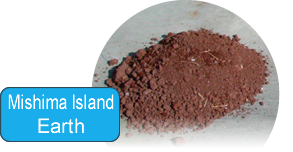
This earth is taken from Mishima Island, 45km off Hagi. There is a high iron content which is evident in its reddish black color. It is mixed with other materials to improve its texture.
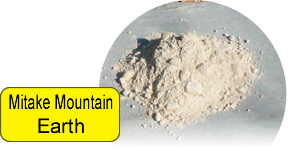
This earth is white in color and of the quality of the kaolin clay used for making celadon ware. In order to raise its resistance to heat, it is mixed with Daidō earth before use. It is dug up from Mitake in the Fukui Shimo area of Hagi City.
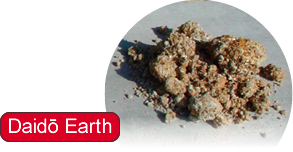
The main earth used for Hagi yaki is taken from the Daidō district of Hōfu City and the Suzenji Yotsutsuji area of Yamaguchi City. This ash-grey earth has a relatively low iron content, whilst its malleability is high, making it a suitable texture for pottery.
Hagi Yaki Glaze
There are two main classes of glaze used to make Hagi yaki. The first is‘biwayū’which is a smooth class of glazes that dissolve well and fire to transparency, enhancing the color of the earth from which the pottery was made. The second is‘white Hagi glaze’, also known as‘Kyūsetsu white.’This glaze has a very thick and fluffy texture and can be fired to high temperatures.

A transparent glaze also known as wood-ash glaze and earth-ash glaze. It is a solvent solution of ash from various varieties of trees, such as pine, sawtooth oak, Isu tree and Japanese oak. For Hagi yaki, this mixture is combined with feldspar minerals at a ratio of 5:5 to make a compound. During the firing process the amalgamation of clay and glaze creates a lemon yellow color. In the case of tea ware, this glaze is known as Biwayū after the orange-colored loquat fruit (biwa fruit) and is a highly appreciated aspect of this glaze.

A straw-ash glaze also known as white glaze or ‘straw white.’ Cloudiness occurs through the process of devitrification when a straw-ash glaze is added to an earth-ash glaze. This look is seen in many pottery styles of western Japan such as Karatsu ware, Agano ware, Takatori ware and Satsuma ware which became popular during the turn of the 16th and 17th centuries. Because these styles were imported from the Korean Peninsula, they were believed to be Korean in origin. However, in recent years, it is also thought possible that this style has connection to potteries of the Fujian and Guangdong provinces in China.
Features of Hagi Yaki Pottery
The Hagi yaki produced by the domain potteries consisted mainly of tea cups, tea bowls and other water containers for tea ceremony. In modern times, the production potters and studio potters who inherited the traditions of Hagi Yaki still produce tea bowls as newly created products.
Tsuchi aji
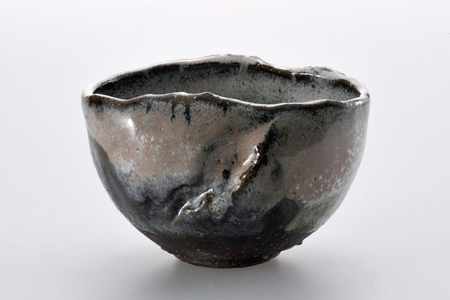
Carved-out tea bowl, ash-glazed
Kaneta Masanao
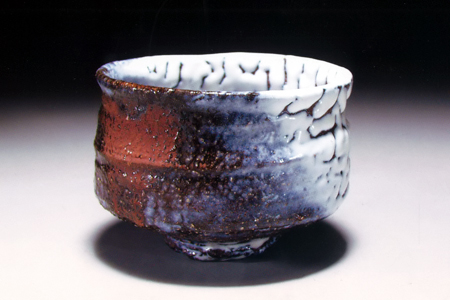
Hagi tea bowl, plumb blossom glaze
Ogawa Hironobu
Biwayū

Hagi tea bowl
Suizu Kazuyuki

Hagi tea bowl
Yoshino Tōri
White Hagi Glaze
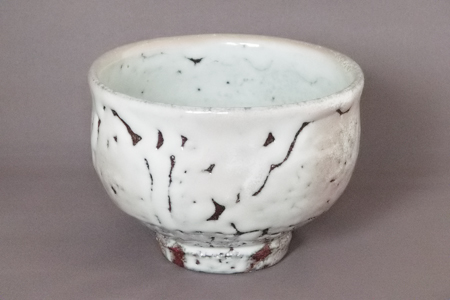
White Hagi tea bowl
Ōtani Masahiko

Chamfered tea bowl, white Hagi glaze
Funasaki Tōru
The‘Seven Disguises’of Hagi Yaki
A renowned aspect of Hagi yaki are the ‘seven disguises’ of Hagi ware. With prolonged use, tea residues seep into the crazing of the glaze, eventually altering the color of the Hagi ware. This delicate process is thought to improve the charm of the piece.
Hagi yaki is fired slowly at comparatively low temperatures in climbing kilns, meaning that the pottery is softer and hence more porous. The craze is determined by the rate of shrinkage when fired, but whatever its appearance, with long use the resulting Hagi ware will come to embody the sense of imperfection and transience which is encapsulated in the term ‘wabi-sabi.’
Since long ago the saying, ‘first Raku, second Hagi, third Karatsu’ has long been used to refer to tea ceremony ware. The phrase lists the highest quality tea ceremony pottery of Japan. The fact that Hagi yaki is included in this saying is testament to the high quality of Hagi ware.
Using Hagi Yaki
Because of the porous nature of Hagi ware, tea residue seeps into the craze and alters the color over time. This is a special feature of Hagi yaki known as the ‘seven disguises,’ but if the pottery is not looked after properly, it can become rotten.
Before Use
Soak the Hagi yaki ware in water for half a day and allow it to air-dry fully. This will lengthen the useful life of the Hagi yaki. For Hagi yaki which already has crazing, repeat the same process regularly to guard against cooking oil or other liquids seeping inside.
Depending on the nature of the clay, water may leak out during the first usage. If this problem continues, pour a thick matcha tea solution, or rice gruel into the Hagi ware and allow it to sit in the pottery for a day before washing it out.
Storage
After use wash well with water by hand. After wiping it, allow the Hagi ware to air-dry fully before storage.


